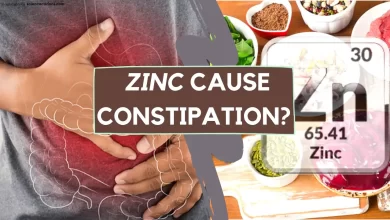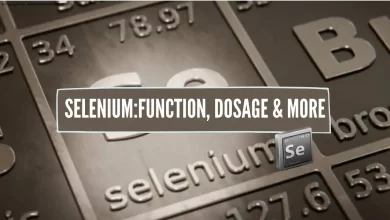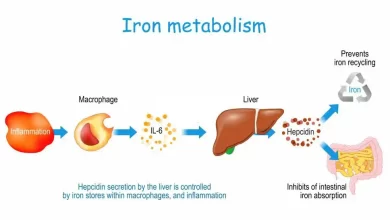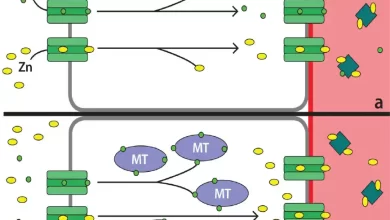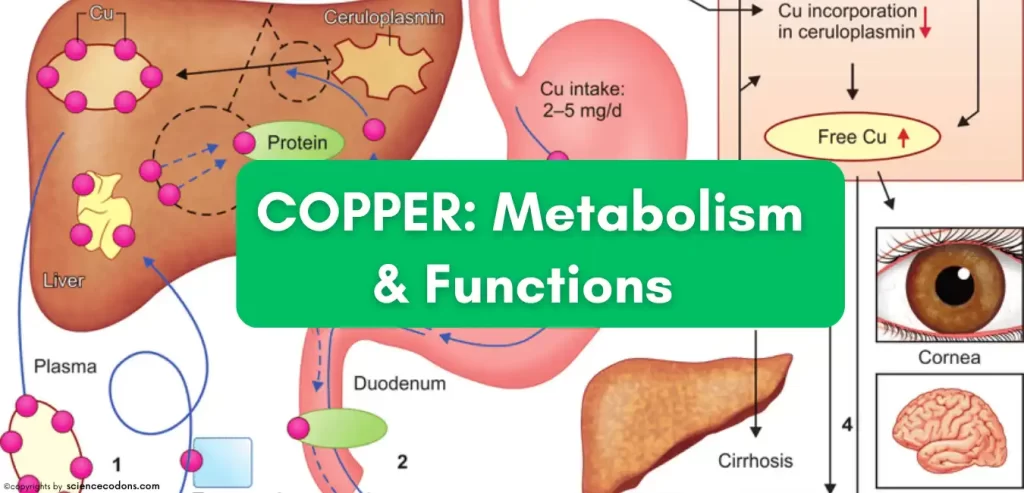
The amount of copper (Cu, atomic number 29, atomic mass 62) present in the human body is approximately 90 milligrams. While about two-thirds of the body’s copper is found in the muscles and bones, the liver is a key organ in copper homeostasis.
Copper metabolism
Copper is found in high quantities in red meat and cereals, but it is present in lower amounts in chicken meat and legume products. The recommended daily intake of copper is approximately 1.6 milligrams. The absorption of copper in the digestive system ranges from approximately 20% for high intake (over 5 milligrams) to about 50% for low intake (less than 1 milligram). Various dietary components influence the absorption of copper in the digestive system. Zinc, molybdate, and iron can reduce copper absorption, while amino acids and sodium can increase it. (more information about copper absorption)
Absorbed copper, in the form of albumin, is transferred to the liver through the portal vein. It is then incorporated into enzymes and copper-containing proteins, which are distributed to different tissues and organs. More than 90% of the copper that is transported out of the liver is in the form of ceruloplasmin, a glycoprotein. Less than 10% of blood copper is bound to albumin, which is believed to be the crucial portion for cellular absorption of this metal.
Where does copper go in the body?
Tissue levels of copper and other metals, like zinc, are regulated to some extent by metallothioneins. This group of small proteins is found in the cytosol of various cells, particularly in the liver, kidneys, and intestines. Metallothioneins, with their high cysteine content, can bind to copper, zinc, cadmium, and mercury through sulfhydryl groups. Acute consumption of these metals leads to an increase in the synthesis of metallothioneins, which likely protect the body from their toxic effects by absorbing them.
Copper is primarily excreted through feces, which includes unabsorbed dietary copper and copper found in gastric and biliary secretions, amounting to approximately 0.5 – 2 milligrams per day. Patients with obstructive jaundice or other liver disorders are at risk of copper accumulation. Copper excretion through urine and sweat is minimal, accounting for less than 3% of daily consumption.
Copper function

Copper is an important and scarce element found in the human body, present in the structure of various metalloproteins. Copper ions can exist in biological systems in two forms: cuprous monovalent (Cu+) and cupric divalent (Cu2+). The activity of copper metalloproteins involves oxidation-reduction reactions. Most copper-containing enzymes either bind directly to molecular oxygen or interact with it. Copper metalloenzymes, such as ceruloplasmin, cytochrome oxidase, superoxide dismutase, tyrosinase, dopamine B-hydroxylase, lysyl oxidase, and 4-desaturase, play important roles in various biological processes. Copper is essential for iron metabolism. After copper deficiency, iron absorption disorders may occur, and severe copper deficiency can lead to anemia. Ceruloplasmin, the primary copper-containing protein in the bloodstream, facilitates the conversion of ferrous ions to ferric ions through its ferroxidase activity. These ions then bind to transferrin in plasma.
What are the issues with copper metabolism?
Copper Overload and Deficiency
Copper deficiency is uncommon, but it can occur in certain cases, such as malnutrition, malabsorption, and conditions that involve chronic copper excretion. The susceptibility of premature infants to copper deficiency is determined by the copper reserves in their liver and spleen, which develop during the final trimester of fetal life.
Menke disease is an X-linked recessive disorder caused by a mutation in an ATPase gene that plays a crucial role in copper transport. In this disease, copper is naturally absorbed into normal mucosal cells, but a defect in its transport out of the cell causes copper to accumulate in the mucosal cell, leading to copper deficiency. A clinical symptom of copper deficiency is brittle hair. Menkes disease is also known as kinky hair syndrome or steely hair disease.
The deficiency of copper ions can disrupt enzyme activity, leading to various abnormalities. Copper is essential for maintaining myelin. (more information about Copper diseases)
| Enzyme | Function | Related Disorder |
|---|---|---|
| ATP7A | Copper transport | Menkes disease |
| ATP7B | Copper transport | Wilson disease |
| SOD1 | Antioxidant defense | Amyotrophic lateral sclerosis (ALS) |
| Lysyl oxidase | Collagen cross-linking | Connective tissue disorders |
| Tyrosinase | Melanin synthesis | Albinism |
| Dopamine beta-hydroxylase | Catecholamine synthesis | Orthostatic hypotension |
| Cytochrome c oxidase | Mitochondrial respiration | Leigh syndrome |
High intake of copper compounds can lead to acute copper poisoning, resulting in symptoms such as nausea and vomiting. Chronic copper poisoning, caused by prolonged consumption of excessive amounts, can lead to liver cirrhosis. This condition is more commonly observed in children who consume milk boiled in copper vessels. Excessive copper can damage proteins, lipids, and nucleic acids by generating free radicals.
Wilson’s disease, also known as hepato-lenticular degeneration, is an inherited disease and characterized by a disorder in ATPase activity. In Wilson’s disease, there is normal copper transfer from the intestine to the liver, but there is a problem with its transfer from the liver to the bile. The accumulation of copper in the liver, kidneys, brain, and lens leads to liver cirrhosis, brain damage, and the formation of Kayser-Fleischer rings in the cornea. This is caused by a disorder in the placement of copper in the structure of the smooth endoplasmic reticulum (sER). The levels of this protein in the serum decrease, while free copper and albumin-bound copper increase. Additionally, there is an increase in the excretion of copper in the urine.
conclusion
Copper metabolism involves the transfer of albumin to the liver, where it is incorporated into enzymes and proteins. Metallothioneins regulate tissue levels of copper and other metals. Copper is primarily excreted through feces and urine, with patients with liver disorders at risk. It is essential for iron metabolism and plays a role in various biological processes.


